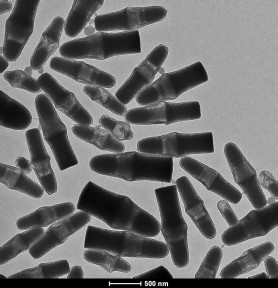
Fabian Hagemans
Leonard S. Ornstein Laboratory, room 0.56
Princetonplein 1, 3584 CC Utrecht
P.O. Box 80 000, 3508 TA Utrecht
The Netherlands
phone: +31 (0)30 253 2320
secretariat: +31 (0)30 253 2952
e-mail: f.hagemans@uu.nl
Research
Supervisor: Dr. Arnout Imhof
Promotor: Prof. dr. Alfons van Blaaderen
Employed since October 2013
Funded by NWO
Colloidal synthesis, Transmission electron microscopy (TEM), NMR spectroscopy
Synthetic methodologies towards anisotropic colloidal particles have attracted significant attention because of their high importance in assembly strategies. The interest in these particles with unusual shapes comes from their high potential in chemical, electrical, and optical applications, but also as model systems for studying self-assembly. Recent advances in the synthesis of these anisotropic particles have supplied us with a large variety of anisotropic colloidal building blocks. Recently, a new colloidal system was developed which consists of rod-like silica colloids.1,2 These particles can be produced in batch synthesis, are monodisperse, and can be easily functionalized by grafting or by the incorporation of a silane coupling agent.
My project involves the shape-transformation of these rod-shaped colloids. The silica rods grow in a linear fashion from a water droplet that serves as the locus for silica growth. Due to their gradient in composition, I was able to transform these particles into a cone or concave shape by etching with a moderate base.
The length-wise growth allows us to change the chemical composition across the length of the particle in steps. By tailoring the nanochemical properties of these particles, one can obtain control over the particle’s shape, mobility, reactivity, assembly and optical properties. In this project I obtained control over the particle shape by tailoring these nanochemical properties of the silica rods.
The chemical composition of these particles was found to be precisely tunable. Upon locally tuning the chemical composition, we were able to selectively etch a segment of the rods. Depending on reactions conditions, we were able selectively etch the tip, the middle segment or the tail. Further tuning of the composition resulted in double-cone and rod-cone particles. Currently I’m measuring these changes in chemical composition by making use of 29Si Solid State NMR spectroscopy.

Figure 1: TEM-image of hollow silica rods obtained by etching segmented silica rods with moderate base.
[1] A. Kuijk et al., J. Am. Chem. Soc. 133, 2346-2349 (2011)
[2] A. Kuijk et al., Particle and Particle Systems Characterization (2014)
In this project rodlike microparticles will be prepared with a chemical gradient which changes between the ends in small steps or in one big step. The behaviour of these particles can be tuned with an electric field, chemical reaction or light.
Colloidal synthesis, Confocal fluorescence microscopy, Transmission electron microscopy (TEM), Scanning electron microscopy (SEM)
In this project rodlike microparticles will be prepared with a chemical gradient which changes between the ends in small steps or in one big step. The behaviour of these particles can be tuned with an electric field, chemical reaction or light.
Synthetic methodologies towards anisotropic colloidal particles have attracted significant attention because of their high importance in assembly strategies. The interest in these particles with unusual shapes comes from their high potential in chemical, electrical, and optical applications, but also as model systems for studying self-assembly. Recent advances in the synthesis of these anisotropic particles have supplied us with a large variety of anisotropic colloidal building blocks. Recently, a new colloidal system was developed which consists of rod-like silica colloids [1, 2]. These particles can be produced in batch synthesis, are monodisperse, and can be easily functionalized by grafting or by the incorporation of a silane coupling agent. This system allows the real-space 3D study of their self-assemblies into various liquid crystalline phases.
My project involves the synthesis of rod-shaped colloids with a chemical composition that varies along their length. The silica rods grow in a linear fashion from a water droplet that serves as the locus for silica growth. The length-wise growth allows us to change the chemical composition across the length of the particle in steps or in a gradient during way. By tailoring the nanochemical properties of these particles, one can obtain control over the particle’s shape, mobility, reactivity, assembly and optical properties.
These micron-sized silica rods were found to transform into a cone-shape upon etching with a moderate base. The mechanism of etching involves silica etching, which takes place with varying rates along the particle’s length. Depending on reactions conditions, we were able to obtain cone-shaped, concave-shaped particles with varying aspect ratios. Our experiments gave us new insights in the particle composition, which gradually changes along the length of the rod. Deliberately applying a gradient in the particle’s length by the delayed addition of 3-aminopropyltriethoxysilane allows us to change the composition in a stepwise way, and such allows us to prepare a variety of particle morphologies.

Figure 1: TEM-image of cone-shaped silica colloids obtained by etching silica rods with a moderate base for 24 hours.
[1] A. Kuijk et al., J. Am. Chem. Soc. 133, 2346-2349 (2011)
[2] A. Kuijk et al., Particle and Particle Systems Characterization (2014)
